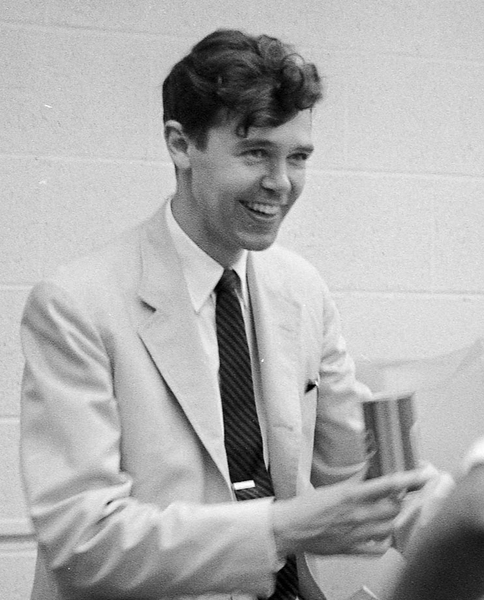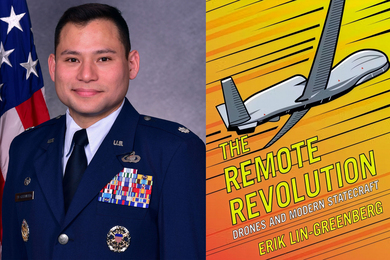Chemistry Professor Emeritus Klaus Biemann passed away peacefully on June 2 after a short illness. He was 89.
Born in Innsbruck, Austria, in 1926, Biemann studied chemistry at the University of Innsbruck where, in 1951, he received a PhD in organic chemistry under the tutelage of Professor Hermann Bretschneider. On completion of his doctoral studies, he remained at the university in the capacity of instructor until 1955. In 1954, however, he applied for and was accepted into a summer program at MIT for young European scientists and engineers. This Fulbright-backed fellowship enabled him to spend six months of that year in the Department of Chemistry at MIT before returning to Austria. Conversing with passengers on the ship to the U.S., he “figured out that MIT must be something special,” he later said. He had little knowledge of the Institute, but observed that travelers were highly impressed when they learned that it was his destination.
In 1955, Biemann returned to MIT to take up a postdoctoral position as a research assistant in the group of Professor George H. Büchi. His work in the Büchi lab centered on structural problems of natural products, and one of his major projects involved synthesis of muscopyridine for the purpose of proving a structure that Büchi had proposed on biogenetic grounds.
In September of 1957, Biemann was appointed to a faculty position in the analytical division of the department by department head Arthur C. Cope. Despite his background in organic synthesis, Biemann centered his research program in analytical chemistry. The project Biemann set for his group was to explore the use of mass spectrometry in the determination of structure of organic compounds including peptides/proteins.
A serendipitous event had led Biemann into this area of research. Attending a 1956 Chicago conference on flavors and fragrances while still a research assistant with Büchi, Biemann learned of mass spectrometry from a paper presented by William H. Stahl of the U.S. Army Quartermaster Corps. Biemann saw how, coupled with his synthetic chemistry skills, mass spectrometry might be developed as a powerful tool in his proposed study of peptides. With encouragement and financial support from Cope, he purchased a Consolidated Electrodynamics Corporation 21–103C mass spectrometer in 1958 — at that time a workhorse in the petrochemical industry, and a very costly instrument. Cope later told Biemann that the money he had obtained from the MIT administration for Klaus' mass spectrometer was the best investment he [Cope] had ever made.
“It was apparent to me,” says Department of Chemistry Professor Emeritus Fred Greene, recalling a conversation with Klaus a few years ago, “that Professor Cope's comment really pleased him. And, indeed, Cope's action made a huge difference to the field of mass spectrometry, to the department, and to Klaus."
"On a personal note,” Greene continues, “Klaus was such a gracious person. And a thoughtful person. It was a real gift to me to have had these interactions with him in our shared emeritus office, 18-297.”
Six years later, Biemann’s graduate students and and postdocs began teaching themselves FORTRAN in order to design spectral interpretation algorithms. A 15-foot wide IBM 1800 computer quickly became a very important part of the Biemann laboratory. The groundwork for a new field in biochemistry — proteomics — had been laid.
“With Klaus Biemann’s passing, science has lost a true hero,” says Harry S. Hertz, former graduate student in the Biemann lab and director of the Baldridge Performance Excellence Program at the National Institute of Standards and Technology. “When each of us joined Klaus’ research group, we quickly learned that we had joined something extraordinary. Klaus was a great mentor; he challenged us to imagine and ‘strongly encouraged’ us to deliver. It was a special time for each of us. We discovered the excitement of scientific research and the power of collaboration. We were truly a research group. But what made it even more special was Klaus, the person. He was a man who taught us about scientific integrity and brought the highest regard for each of us as a person to our interactions with him and each other. We achieved because we were in an environment of greatness, with Klaus as our guide.”
Ultimately, 150 graduate students and postdocs would benefit from Biemann’s tutelage and mentorship, and hundreds more are his professional progeny through the many of his direct descendents who undertook academic careers, largely inspired by his example and leadership. They represent the core of the worldwide mass spectrometry community.
“With his students and postdocs, Klaus was simultaneously formal, demanding, infallibly supportive, and an unfailing source of good humor,” says John Hayes, a former graduate student and scientist emeritus of the Woods Hole Oceanographic Institution. “He inspired do-or-die effort and respect that came from the heart as well as the mind. Among his many honors, this may be the greatest.”
Another graduate student from the Biemann lab, Ron Hites, distinguished professor at Indiana University, says the following about his PhD advisor: “Klaus taught all of us who passed through his research group how to do research and, more importantly, how to communicate our work — keep to a simple story and focus on the big picture. ... He was always supportive and courteous. I owe him a lot.”
Rising through the ranks, Biemann was appointed to assistant professor in 1959, associate professor in 1962, and full professor in 1963. Regarded as the father of organic mass spectrometry, his approach over the years enabled him to solve many problems in protein structure not amenable to existing methods.
Catherine Costello, the William F. Warren Distinguished Professor and director of the Center for Biomedical Mass Spectrometry at Boston University, who was a colleague of Biemann for more than 20 years at MIT, points out: “His impact on engaging scientists in adjacent fields to utilize mass spectrometry resulted from his constant outreach to other chemists, to biologists and to those in the medical professions, to identify areas of research where mass spectrometry could make a novel and unique contributions and to drive the development of mass spectrometry systems to accommodate those needs. He set up the first NIH Research Resource in 1966, to make these techniques available to the community and this center continued to lead technological developments and applications for 30 years.”
“The revolution in mass spectrometry that has made it one of the most important tools not only in chemistry but also in biology owes everything to the pioneering work of Klaus Biemann,” says Greg Petsko, the Gyula and Katica Tauber Professor of Biochemistry and Chemistry Emeritus at Brandeis University and adjunct professor in the Department of Neurology and Center for Neurologic Diseases at Harvard Medical School and Brigham and Women's Hospital. “He made analytical chemistry, which had been relegated to a minor role as a servant of organic synthesis, once again a central part of the discipline. On a personal note, he was kind, generous, and constantly supportive of young scientists. A true gentleman scholar.”
Among the first entire proteins to be sequenced in this way by the Biemann group was the light-responsive protein bacteriorhodopsin, in collaboration with Professor H. Gobind Khorana, and an aminoacyl t-RNA synthetase enzyme important in the process of building up a protein one amino acid at a time.
In 1976, Biemann led a scientific team that sent a miniaturized mass spectrometer to Mars as part of the Viking Mission to look for organic compounds at the surface of the Red Planet. Mass spectrometry on lunar material returned by the Apollo missions had earlier been conducted in Biemann’s lab in the basement of Building 56. Biemann described his decades of participation in what is commonly called space research, beginning in 1963, as quite unrelated to his other organic and biochemical work. “However,” he stated in the Annual Review of Analytical Chemistry, “it required expertise in organic mass spectrometry, and I felt I should get involved.” He ironically described it as “scientific charity,” but also remarked it was an unforgettable experience. This he largely attributed to Viking’s unique team environment and the mutual appreciation that developed over the years of planning, and then being together at the Jet Propulsion Laboratory during the landed mission among the scientists of various disciplines, all working toward a common goal, the understanding of our neighboring planet.
“Klaus was a world-class scientist and inventor, a pioneer whose contributions highlight how technological innovation enables scientific advancement,” says Timothy Jamison, head of the Department of Chemistry, on learning of Biemann’s passing.
Biemann’s many awards and honors include the 2007 Benjamin Franklin Medal in Chemistry, the Thomson Medal from the International Mass Spectrometry Foundation (1991), the first Field and Franklin Award in Mass Spectrometry from the American Chemical Society (1986), the Fritz Pregl Medal of the Austrian Microchemical Society (1977), the Exceptional Scientific Achievement Medal from NASA (1977), and the Stas Medal of the Belgian Chemical Society (1962). He was elected to the National Academy of Science in 1993 and a fellow of the American Academy of Arts and Sciences in 1966. He authored over 350 scientific publications and a book, "Mass Spectrometry: Organic Chemical Applications" (1962). The American Society of Mass Spectrometry annually recognizes an early-career scientist’s mass spectrometry achievements with the bestowal of the Biemann Medal.
Biemann and his wife Vera, who predeceased him in 2008, and their children Hans-Peter and Betsy, were faculty residents at McCormick Hall from 1967 to 1971.
Services will be private with immediate family. In lieu of flowers, donations may be made to “Science Scholarship” and sent to Trustees of Trust Fund, P.O. Box 608, Alton, NH 03809. Biemann had a home in Alton and had established this fund for students of Prospect Mountain High School who are interested in embarking on a career in science.







